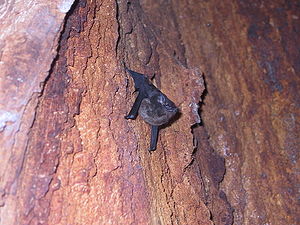Diclidurini
| Diclidurini | ||||||||||||
|---|---|---|---|---|---|---|---|---|---|---|---|---|

|
||||||||||||
| Systematics | ||||||||||||
|
||||||||||||
| Scientific name | ||||||||||||
| Diclidurini | ||||||||||||
| Gray , 1866 |
The Diclidurini are a tribe of the bat family of the smooth-nosed free-tailed bat (Emballonuridae). This taxon summarizes all species of this family that live in America . It includes around 20 species in eight genera.
The distribution area of the Diclidurini extends from southern Mexico to Bolivia and southeastern Brazil , but does not include the Caribbean islands.
description
Diclidurini are relatively small bats, they reach a head body length of four to eight centimeters and a weight of four to 15 grams. The fur of most species is brownish or greyish in color, with the underside usually being slightly lighter. The American ghost bats ( Diclidurus ), however, have a white fur. Two genera, the two-striped bat ( Saccopteryx ) and the nose bat ( Rhynchonycteris ) have two white wavy lines on their backs. All species are characterized by the relatively elongated, pointed snout; As with all smooth-nosed canters, the nasal blade is missing. Most species have sac-shaped glands on the top of the wings and often another gland at the base of the tail. The tail is short and protrudes a bit from the uropatagium (the flight membrane between the legs).
Way of life
Most species live in forests, but some animals are also found in open areas, such as savannahs. Many species seek the vicinity of water, they sleep close to the water and also look for their food, which in all species consists almost exclusively of insects, over rivers and lakes. In contrast to many other bats, the Diclidurini prefer more exposed sleeping places, for example on trees (on the trunks or under leaves), in tree hollows or on open rocks. Some species are known to have a dominant male gathering a harem of females, while one species, Saccoptery leptura , is likely to live in monogamous relationships. Several species live in small to medium-sized groups.
Genera and species
- Balantiopteryx : The three species of the genus Balantiopteryx are distributed from southern Mexico to the northwest of Ecuador . These animals live in large colonies, often of several thousand animals. The three species are Balantiopteryx infusca , Balantiopteryx io and Balantiopteryx plicata .
- Centronycteris : The two species of this genus, the spur sheath tail ( Centronycteris maximiliani ) and Centronycteris centralis , are calledShaggy batsin English because of their shaggy fur. They are rarely seen as they prefer dense forests as a habitat. Their homeland stretches from southern Mexico to Brazil .
- Cormura : This genus includes only one species, Cormura brevirostris , which is distributed from Nicaragua to Peru and central Brazil. The color of their fur varies from black-brown to reddish.
- Cyttarops : The only species in this genus, Cyttarops alecto , is characterized by its short ears. It occurs from Nicaragua to northern Brazil.
- American ghost bats ( Diclidurus ): The four species of American ghost bats are colored white or white-gray and are the only bat genus with this characteristic besides the white bat ( Ectophylla alba ). They are the largest representatives of the Diclidurini and spread from southern Mexico to the Amazon region of Brazil.
- Peropteryx : The genus Peropteryx is known as dog-like bats (dog-like bats) because of its pointed, narrow snout. The four species occur from Mexico to southern Brazil. Their body is dark brown in color, in contrast to the other species, Peropteryx leucopterus stands out due to the white colored wings.
- Rhynchonycteris : A long, slightly upwardly curved snout is the hallmark of the only species of this genus, the nose bat ( Rhynchonycteris naso ). Their fur is gray and long, and their back has two wavy white lines. Weighing two to four grams, it is one of the smallest bat species. Their distribution area extends from southern Mexico to southeastern Brazil.
- Sac-winged bats ( Saccopteryx )